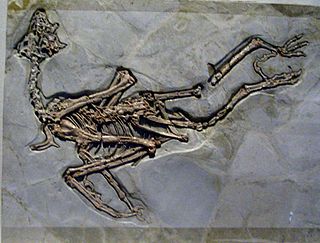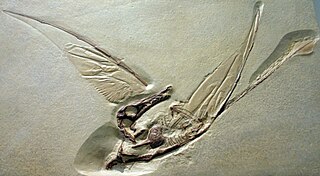
Davidson Black, was a Canadian paleoanthropologist, best known for his naming of Sinanthropus pekinensis. He was Chairman of the Geological Survey of China and a Fellow of the Royal Society. He was known as 步達生 in China.

Shantungosaurus is a genus of very large saurolophine hadrosaurid dinosaur found in the Late Cretaceous Wangshi Group of the Shandong Peninsula in China, containing a single species, Shantungosaurus giganteus. The stratigraphic interval of Shantungosaurus ranges from the top of the Xingezhuang Formation to the middle of the Hongtuya Formation, middle to late Campanian in age. Shantungosaurus is so far the largest hadrosauroid taxon in the world, with size estimates around 15–17 metres (49–56 ft) in length and 13–16 metric tons in body mass.
The Ziliujing Formation is a geological formation in China, It is Early Jurassic in age. It is part of the stratigraphy of the Sichuan Basin. The dinosaur Gongxianosaurus and indeterminate theropod material are known from the Dongyuemiao Member of the formation, as well as dinosaur footprints, Zizhongosaurus and indeterminate prosauropods from the Da'anzhai Member. The basal sauropod Sanpasaurus is known from the Maanshan Member. An unnamed stegosaur and the pliosauroid plesiosaur Sinopliosaurus are also known from this formation but they were found an indeterminate member. An unnamed teleosaurid known from a complete skull has also been found in the formation, pending a formal description. The deposition environment during the Da'anzhai Member in the lower Toarcian is thought to have been that of a giant freshwater lake encompassing the whole of the Sichuan basin, around 3 times larger than Lake Superior, coeval with the Toarcian Oceanic Anoxic Event around 183 Ma.
Dapingfangornis was an enantiornithean bird. It lived during the Early Cretaceous and is known from fossils—including a complete skeleton—found in the Jiufotang Formation in Liaoning province, People's Republic of China. Small to medium-sized, it had a sternum with both long and short lateral processes, and a unique thorn-like process on its nares.

Omnivoropterygidae is a family of primitive avialan dinosaurs known exclusively from the Jiufotang Formation of China, though putative omnivoropterygids are known from the Maevarano Formation of the Maastrichtian of Madagascar. They had short skeletal tails and unusual skulls with teeth in the upper, but not lower, jaws. Their unique dentition has led some scientists to suggest an omnivorous diet for them. The family was named by Stephen A. Czerkas & Qiang Ji in 2002, though its junior synonym Sapeornithidae is often used instead, though it was named four years later in 2006. It is the only named family in the order Omnivoropterygiformes.
Eomamenchisaurus is a genus of mamenchisaurid sauropod dinosaur from the Middle Jurassic Zhanghe Formation of Yuanmou, Yunnan, China. The type species is E. yuanmouensis, described by Lü Junchang et al. in 2008.
The Xinlong Formation is an Early Cretaceous geologic formation in Guangxi, southern China.
The Haifanggou Formation, also known as the Jiulongshan Formation, is a fossil-bearing rock deposit located near Daohugou village of Ningcheng County, in Inner Mongolia, northeastern China.

Zhenyuanopterus is a genus of boreopterid pterosaur which is known from Lower Cretaceous Yixian Formation of Liaoning, China. It contains one species, Zhenyuanopterus longirostris, which was first described and named by Lü Junchang.

Rhamphorhynchidae is a group of early pterosaurs named after Rhamphorhynchus, that lived in the Late Jurassic. The family Rhamphorhynchidae was named in 1870 by Harry Govier Seeley. Members of the group possess no more than 11 pairs of teeth in the rostrum, a deltopectoral crest that is constricted at the base but expanded at the distal end, and a bent phalange on the fifth toe.

Euctenochasmatia is an extinct group of pterodactyloid pterosaurs. It was named by David Unwin in 2003 as the group that contains the most recent common ancestor of Pterodactylus and Ctenochasma, and all their descendants.
Jianchangopterus is a genus of scaphognathine rhamphorhynchid pterosaur from the Middle Jurassic of western Liaoning, China. Jianchangopterus is known from a nearly complete skeleton with skull preserved. It was collected from the Tiaojishan Formation. It was first named by Lü Junchang and Bo Xue in 2011 and the type species is Jianchangopterus zhaoianus.
Westergaardodina is a species-rich genus of spine, U or W-shaped paraconodont known from Middle Cambrian to Lower Ordovician strata.
Xinghaiornis is an extinct genus of toothless basal ornithothoracine dinosaur known from the Early Cretaceous Yixian Formation of western Liaoning Province, northeastern China. Xinghaiornis was first named by Xuri Wang, Luis M. Chiappe, Fangfang Teng and Qiang Ji in 2013 and the type species is Xinghaiornis lini. Xinghaiornis was prepared by Maureen Walsh at the Dalian Museum of Prehistory, Dalian, China.
Pangupterus is a genus of pterodactyloid pterosaur from the Early Cretaceous Jiufotang Formation of China. It was first described and named by Lü Junchang et al.
The Chaochuan Formation is a geologic formation in China. It is made up of purplish red calcarenaceous, muddy siltstone, fine-grained sandstone with interbeds of tuffaceous sandstone and conglomerate or rhyolitic tuff.
Luopterus is an extinct genus of anurognathid pterosaur containing only the holotype species L. mutoudengensis that is known from the Middle Jurassic Tiaojishan Formation of Qinglong, northern Hebei Province, China. It was originally named as a species of Dendrorhynchoides in 2012 but it was moved to the genus Luopterus in 2020. Luopterus was originally thought to be from the Early Cretaceous, with a wingspan that is about 40 centimeters (16 in), making it one of the smallest known pterosaurs.
Grabauornis is an extinct genus of enantiornitheans from the Early Cretaceous of China.

Dawazisaurus is an extinct genus of sauropterygian of possible nothosauroid affinities from the Middle Triassic Guanling Formation in China. The type species is D. brevis.

Gongzhucuo is a lake situated on a plateau in Ngari Prefecture of Tibet Autonomous Region in China.










